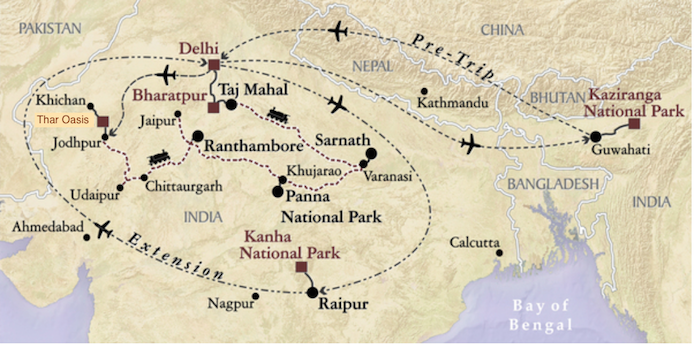
This was our last day at Kanha National Park
(Image courtesy of VENT)
(Click on images to enlarge)

| What we did get was some really splendid birds. In the early morning light, a pair of Indian Scops Owls cuddled at the entrance to their nest hole. And a Crested Serpent-Eagle sat sunning itself in the wan sunshine, its white wing linings deployed to catch some rays. |
|
Indian Scops Owls sleeping, Kanha National Park |
Crested Serpent-Eagle sunning, Kanha National Park |
| I was able to get a good look at a Woolly-necked Stork at last. One of the best birds of the morning was the Velvet-fronted Nuthatch. Who could have imagined that a nuthatch could be blue? |
 Woolly-necked Stork (Image courtesy of Wikimedia Commons) |
 Velvet-fronted Nuthatch (Image courtesy of Wikimedia Commons) |
| We stopped for breakfast in a park compound different from the one we used two days ago, built in an area with enormous Banyan trees. The Hanuman Langurs were waiting for breakfast, too. |
|
Banyan Tree, Kanha National Park |
Hanuman Langur waiting, Kanha National Park |
|
We continued through the park exploring new sections and finding new birds (but
no tigers). Many of the passengers in other jeeps our driver stopped to consult
with looked rather disgruntled, but we were all delighted with our morning as
we kept seeing more and more wonderful birds. We found a pair of Common
Kingfishers outside their nest in a muddy bank looking just gorgeous. They
complained loudly of our presence, however, so we soon left them in peace.
A pair of Crested Treeswifts, one of my most-wanted birds, perched in the open high above us, too high up for us to see their crests, alas. Treeswifts differ from the closely-related true swifts in that the treeswifts can perch on a branch, an ability the true swifts have lost. I have long considered the Moustached Treeswift (which we saw in Papua New Guinea) to be the most beautiful bird I’ve ever seen—not so much a bird as the idea of a bird. |
 Crested Treeswift (Image courtesy of Wikimedia Commons) |
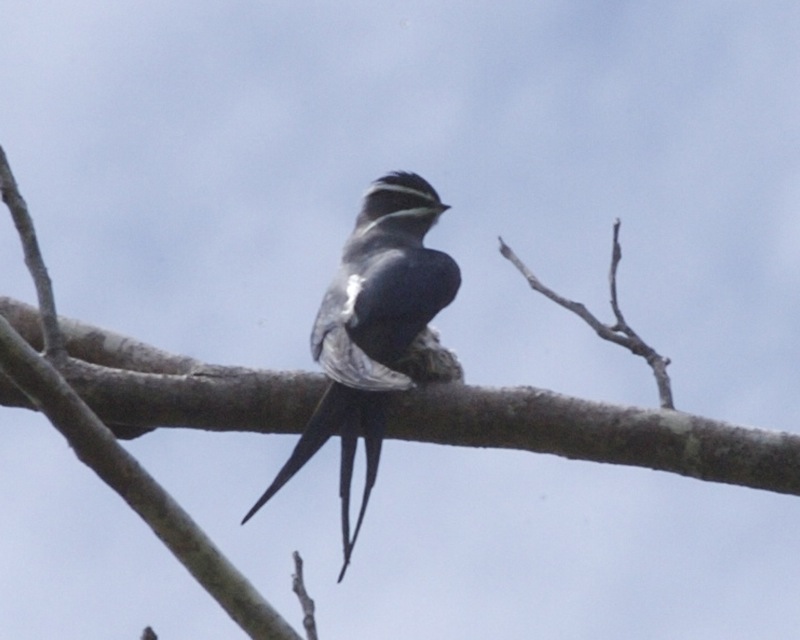 Moustached Treeswift on nest (Image courtesy of Wikimedia Commons) |
| A pair of Scarlet Minivets dazzled us as they flew about, ever so much prettier than I had expected from the book. A wonderful pair of Rufous Woodpeckers gave us a good look. |
 Male Scarlet Minivet (Image courtesy of Wikimedia Commons) |
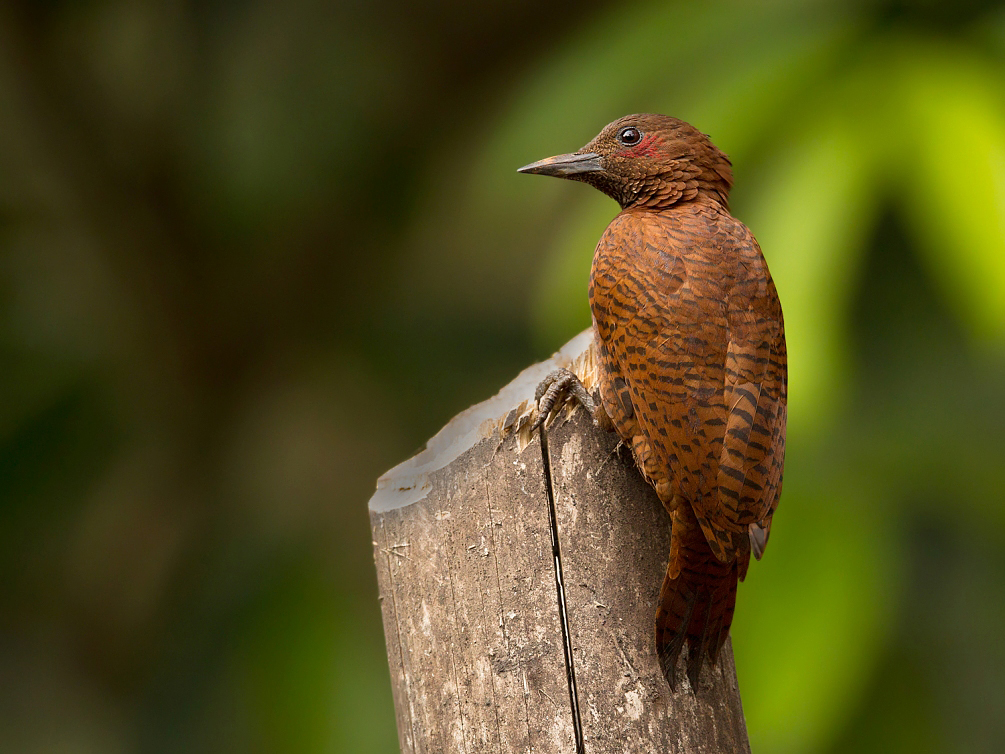 Rufous Woodpecker (Image courtesy of Wikimedia Commons) |
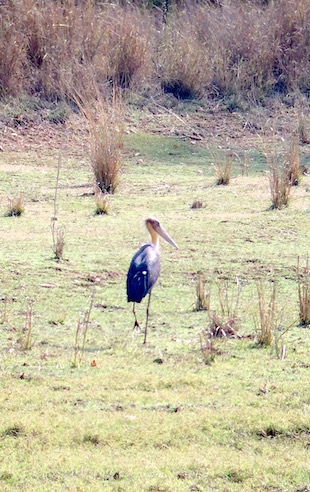 Lesser Adjutant |
I decided to go out for the afternoon drive knowing that it was likely to be
another tiger snark hunt. Lee’s back wouldn’t permit him to go (and
mine was right at the edge of handling all that bumping). For the first time,
our jeep wasn’t the first in line for the opening of the park (though it
was second); this is because we encountered the same ten barricades and had to
convince the skeptical children that we’d already paid.
Gajendra told us that we weren’t going to stop for any birds we’d already seen, only for important things like a Lesser Adjutant (a stork) or a Stork-billed Kingfisher, as we were going to try to get another tiger. Fortunately, a minute later, we did see (and stop for) a Lesser Adjutant, which was another of my most-wanted birds. We spent the rest of the afternoon in pursuit of a tiger. We stayed a long while beside a woodland in which Spotted Deer were giving their alarm call, but no line of sight we tried revealed the tiger causing their alarm. (Lee and I have watched so many videos about tigers that I instantly recognized that alarm call. You can hear it in this video.) We later noticed a tiger’s pug mark in the road overlaying a recent tire track. When we returned to the place where the Spotted Deer had been calling, we heard Barking Deer giving their alarm call, which sounds remarkably like large dogs barking. (You can hear it in this video of a tigress at Kanha.) The only other notable events of the afternoon were seeing the youngest Langur we’d yet seen, a really tiny baby, and arriving at a place where a Sloth Bear had recently been seen, but where there were now only a bunch of jeeps. |
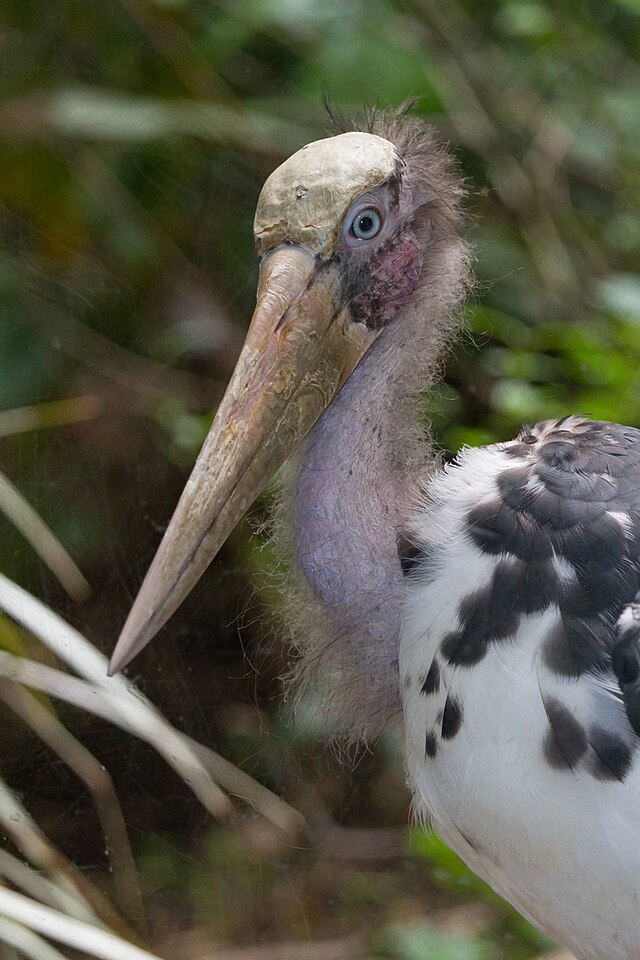 Head of Lesser Adjutant (Image courtesy of Wikimedia Commons) |
| My birds for the day: |
| Lesser Whistling Duck | Comb Duck | Green-winged Teal | Grey Francolin | Red Junglefowl |
| Indian Peafowl | Black Stork | Woolly-necked Stork | Lesser Adjutant | Little Cormorant |
| Eastern Great Egret | Intermediate Egret | Little Egret | Eastern Cattle Egret | Indian Pond Heron |
| Red-naped Ibis | Oriental Honey-Buzzard | Crested Serpent Eagle | Shikra | Yellow-wattled Lapwing |
| Red-wattled Lapwing | Bronze-winged Jacana | Common Snipe | Rock Pigeon | Oriental Turtle Dove |
| Spotted Dove | Yellow-footed Green Pigeon | Indian Scops Owl | Crested Treeswift | Common Kingfisher |
| White-throated Kingfisher | Green Bee-eater | Indian Roller | Eurasian Hoopoe | Indian Grey Hornbill |
| Brown-headed Barbet | Rufous Woodpecker | Black-rumped Flameback | Rose-ringed Parakeet | Scarlet Minivet |
| Large Cuckooshrike | Black Drongo | Greater Racket-tailed Drongo | Rufous Treepie | Indian Jungle Crow |
| Red-rumped Swallow | Cinereous Tit | Velvet-fronted Nuthatch | Red-vented Bulbul | Zitting Cisticola |
| Jungle Babbler | Oriental Magpie-Robin | Red-breasted Flycatcher | Common Myna | Purple Sunbird |
| Paddyfield Pipit | House Sparrow | Chestnut-shouldered Petronia | Red Avadavat |

